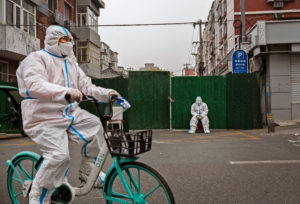Do public inquiries ever deliver public satisfaction? Often, they provide more questions than answers. And rarely in a timely fashion. It took Chilcot seven years to produce his report into the Iraq war, after two previous whitewashes, and the Grenfell Tower inquiry took four and a half years to produce little more than a “merry-go-round of buck-passing” to the tune of £150 million in legal fees.
As two of the key preliminary hearings in the UK Covid Inquiry take place this week — two years after Boris Johnson said “we owe it to the country to produce answers in a reasonable timescale” — bereaved families and policy sceptics could be forgiven for thinking the whole thing is an excuse to kick controversies and failings into the long grass. Will this inquiry follow the pattern of previous ones and avoid the difficult questions?
There are already concerns. With the World Health Organization refusing to provide a statement of evidence, not all the relevant stakeholders are engaging with the process, while bereaved families already feel marginalised. But the Inquiry’s broad Terms Of Reference (TOR) are encouraging: decision-making, the availability and use of data, “legislative and regulatory control and enforcement”, “the use of lockdowns and other ‘non-pharmaceutical’ interventions (NPIs)”, the impact on mental health of the whole population, the specific impacts on young people and education, and the safeguarding of public funds are all included. As are questions of the treatment of Covid-19 in hospitals, care homes, and “the development, delivery and impact of therapeutics and vaccines”, alongside the consequences of the pandemic on provision of non-Covid treatments.
But how will the Inquiry address these issues? Will it simply reinforce the mainstream public and Government messaging — or will it provide a meaningful examination of this peacetime catastrophe? Given the current narrative regarding the most controversial of pandemic measures, “the use of lockdowns and other [NPIs]”, one might perhaps be allowed a little scepticism. That the UK failed to lock down soon enough is pretty much orthodoxy in policy circles. This was the conclusion in October 2021 of the Health and Social Affairs Select Committee, soon repeated by luminaries such as Jeremy Hunt — and trumpeted by Keir Starmer as early as April 2020.
A serious inquiry shouldn’t simply repeat the mantra — it should consider the novelty of the lockdown model (the WHO’s November 2019 pandemic preparedness report into NPIs did not mention the word “lockdown” once), as well as its long-term effectiveness. The TOR encourage the “reasonable regard of relevant international comparisons”, and it’s to be hoped that this is taken seriously. Italy’s national lockdown was the first in world history — and yet it has one of Western Europe’s highest Covid death rates. South Africa’s was the strictest lockdown in Africa, and yet it has far and away the highest Covid death rate on the continent. Peru had one of the world’s strictest lockdowns in 2020, and now has the world’s highest Covid fatality rate.
So this inquiry should seek to understand how and why the world’s political and scientific establishment cohered around a completely untried and untested model for dealing with the Covid outbreak. It should attempt to connect this to some of the other themes in the TOR, especially the question of political decision-making, such as how and why did the UK’s scientific establishment depart from the previous consensus that, as the Government’s chief scientific adviser Sir Patrick Vallance said on March 13, 2020, “If you completely locked down absolutely everything, probably for a period of four months or more then you would suppress this virus… but when you do that and then you release it, it all comes back again.”
And it should seek to interrogate how and why the lockdown approach became unchallengeable, leading to a situation in which 40% of the deaths from Covid-19 in the Western world took place in the most vulnerable of all settings — care homes. Why did the Imperial College modellers’ predictions that the lockdown measures would see fewer than 6,000 people dying from Covid in the UK overestimate the effectiveness of these measures by something like 3,000%? And why was the UK’s pre-2020 pandemic planning — which emphasised balancing the costs and benefits of all interventions according to the principles of proportionality and flexibility, minimising the disruptions to everyday social and economic life, and protecting the vulnerable — thrown out of the window?
This core question should be connected to the broader impact on healthcare. Instead of protecting the NHS, did lockdowns produce the crisis we now see flooding the health service? Should more care have been focused on the vulnerable, while allowing the rest of society to continue as normal? Would this have then mitigated the damaging effects of lockdown on young people and societal mental health, as well as avoiding the immensely regressive consequences of school closures?
Although the effects of lockdown should lie at the heart of the Inquiry, there are other aspects of the pandemic which deserve scrutiny.
Why, for example, did the Government ignore the potential benefits of natural immunity, when evidence suggested early on that prior infection confers durable protective immunity in the case of SARS-CoV2, as confirmed by a study just published in The Lancet? The idea of letting the virus spread through those who were at low risk from it (the overwhelming majority of the population), allowing them to generate antibodies, while protecting high-risk groups, was a well-established epidemiological concept, and yet it was dismissed as outlandish, despite being initially advocated by Patrick Vallance.
Why, too, was compulsory universal masking adopted, despite the fact that no existing data supported the use of face-masking in the general population as a protective measure against respiratory viruses? Even the WHO had originally stated that “the wide use of masks by healthy people in the community setting is not supported by current evidence and carries uncertainties and critical risks” — including lulling elderly and at-risk people into a false sense of security by making them mistakenly believe they will be safe while wearing them. This has now been confirmed by meta-analysis published in January by Cochrane, widely considered the gold standard of healthcare data review. And what was the point in the use of mass testing for the general population, including in very low-risk children, at a massive cost, without evidence of individual or community-wide benefit from doing so?
The question of treatment is often ignored in the heated exchanges around Covid, but it also deserves serious examination. Why was so little research conducted into early at-home treatments for Covid? Based on existing drugs, these had apparently early benefits in reducing hospitalisations and deaths — which were subsequently confirmed in peer-reviewed studies (see here and here) — as early as March 2020. They were ignored, though, even after the publication of a first early treatment protocol based on efficacy and safety in the prestigious American Journal of Medicine in July 2020.
The potential of a number of early treatments was relatively unexplored, even though they might have worked well to prevent infection and illness. Instead, how many people ended up in hospital because all they were told, at the onset of the first symptoms, was to stay at home, rest, and in the case of a high fever to take paracetamol? And then, once they were in hospital, how many of those who developed serious respiratory issues perished because they were placed on mechanical ventilators? During the first wave, this became the mainstay of treatment for severe and critical cases of Covid-19; however, it soon become clear that a shockingly high number of patients put on ventilators ended up dying. It would later emerge that the use of pressurised oxygen was literally destroying patients’ lung sacs that were inflamed and damaged by the virus, and therefore unable to withstand the high pressure of mechanical ventilators. Why was the ventilation protocol maintained for months despite such appalling results?
Finally, why were fast-tracked, experimental, and, ultimately, little-known “next-generation” mRNA technology-based vaccines offered to everyone, including those at little risk from Covid, even though it was known that the vaccines didn’t prevent transmission, and were associated with serious side effects? Wouldn’t a focused, risk-based approach to vaccination have been more advisable?
There are serious questions to be asked about the management of this catastrophe. The scope of the inquiry is necessarily huge. But the politicisation of the debate around Covid is fraught. There are strong headwinds, built up during the initial years when the lockdown consensus was so powerful. But as the failings of the Covid policy response become ever clearer, let’s hope the the British public isn’t lumbered with yet another meaningless inquiry.
Disclaimer
Some of the posts we share are controversial and we do not necessarily agree with them in the whole extend. Sometimes we agree with the content or part of it but we do not agree with the narration or language. Nevertheless we find them somehow interesting, valuable and/or informative or we share them, because we strongly believe in freedom of speech, free press and journalism. We strongly encourage you to have a critical approach to all the content, do your own research and analysis to build your own opinion.
We would be glad to have your feedback.
Source: UnHerd Read the original article here: https://unherd.com/




